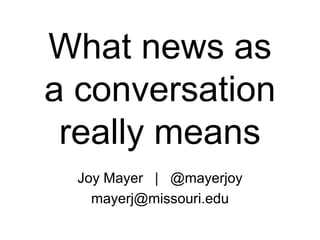#PINCamp13, What does news as a conversation really mean?
- 1. What news as a conversation really means Joy Mayer | @mayerjoy mayerj@missouri.edu
- 3. ŌĆ£HereŌĆÖs something four-year-olds know: a screen without a mouse is missing something. HereŌĆÖs something else they know: media thatŌĆÖs targeted at you but doesnŌĆÖt include you may not be worth sitting still for. ŌĆ” They will just assume that media includes the possibilities of consuming, producing, and sharing side by side, and that those possibilities are open to everyone. How else would you do it?ŌĆØ ŌĆö Clay Shirky, Cognitive Surplus
- 4. WhereŌĆÖs the mouse? Consume. Produce. Share.
- 5. ŌĆ£MutualisationŌĆØ at The Guardian = a constant invitation Model from @MegPickard
- 6. ŌĆ£MutualisationŌĆØ at The Guardian = a constant invitation Model from @MegPickard
- 8. Our invitations tend to be segmented.
- 9. How can we make our invitations ŌĆ” continual? specific? genuine? easy?
- 11. Is the interaction ŌĆö inviting, talking and listening ŌĆö really part of our newsroom culture?
- 13. If we tell users we want to hear from them, are we prepared to follow up? Are we willing to share our agenda- setting duties?
- 14. Shared control. Vulnerability. (like a real relationship?)
- 15. Are we asking for feedback?
- 16. And do we really want it?
- 17. But what if users want to talk about something weŌĆÖre not prepared for?
- 18. But what if they have needs that donŌĆÖt line up with ours?
- 19. But what if their ideas or suggestions are ŌĆ” bad?
- 21. What if they donŌĆÖt want what we think they should want?
- 22. Are we as focused on meeting their needs as we are on enabling them to meet ours?
- 25. What will happen if we hand them the microphone?
- 31. How do you make the mouse more obvious? How do you help your newsrooms see the value? Is your newsroom ready to listen?
Editor's Notes
- #3: Explanation is here: http://joymayer.com/2012/04/07/wheres-the-mouse-my-favorite-shirkyism/
- #5: Such a key principle of PIN ŌĆō how can people interact with and inject themselves into what we do? How are our processes and products social? Collaborative? Open?
- #6: Diagram from Meg Pickard describes the attitude at the core of the GuardianŌĆÖs invitations.This is at the core of how my team and I now approach journalism.
- #7: ItŌĆÖs a conversation, not a lecture. Less about ŌĆ£storiesŌĆØ that get published. More about an ongoing back and forth. That bottom left is key for the strategies of PIN.
- #8: Three Little Pigs ad: http://www.guardian.co.uk/media/video/2012/feb/29/open-journalism-three-little-pigs-advertBe a change agent. Get people in your newsroom to open up. Ask the question for so many stories. How can this approach get to better journalism?Changing attitudes in the newsroom. Get the buy-in. Culture. Find the like minds and point to the success. The kind of journalism thatŌĆÖs possible through it.
- #9: Key turning point in that video is when a user tipped the newsroom off about the inhaler video. That happens best when thereŌĆÖs a standing invitation to interact ŌĆō when journalists are accessible and open.How can we build invitations into more of what we do, not have them as a separate element?
- #13: How often, and how specifically, do we ask readers to tell us what they want to know? What if we were more structured to answer existing questions?The flip side, though, is that we have to be ready for what we get. What if we get questions we donŌĆÖt want? What if users misunderstand what weŌĆÖre asking? What if we have to chase things we donŌĆÖt think are interested or important?
- #18: Following a story on social is a kind of feedback.
- #19: Huge success on one level ŌĆō she took me up on my offer to get in touch with ideas.But also so, so inconvenient, and not at all when I intended when I invited story ideas.
- #21: Do we really want to know? Are we asking the right people?Too often, we pat ourselves on the back for having issued the invitation.
- #22: And sometimes, invitations go nowhere, when weŌĆÖre sure they should have worked. Are we willing to let go?
- #24: Speaking of community, ProPublica is creating them, not just joining them. For meaningful crowdsourcing and continued conversation.There are FB groups locally, to focus on specific ideologies, priorities, interests, etc. If they meet in person, we feel obligated to listen. Why not online?Seattle Times doing it with people who graduated from high school in a certain year, for an economic impact story.
- #25: Future audience. They shared our stories. They let a few of us into their group. TheyŌĆÖre planning to submit a story for From Readers. They feel heard and connected. This is where they talk. The new shoe leather reporting ŌĆō find the community.
- #26: The next slides are two examples of what happens when you open up discussion with no idea what will come next. Show up and listen. Be willing to hear from them.Can they help solve a problem? (And how could I have gotten them in the PIN?) The ŌĆ£how couldŌĆØ questions from yesterday.































